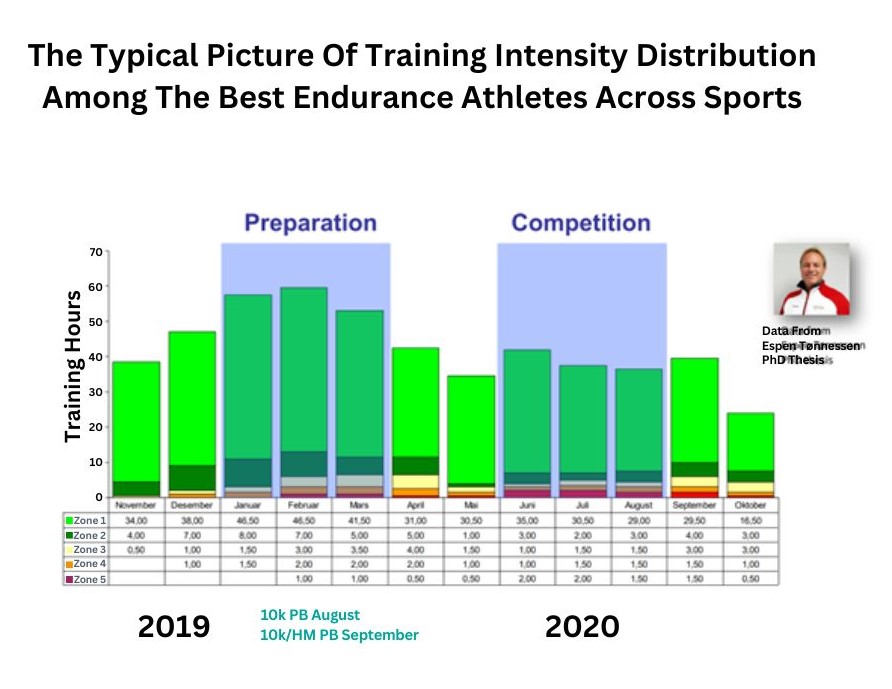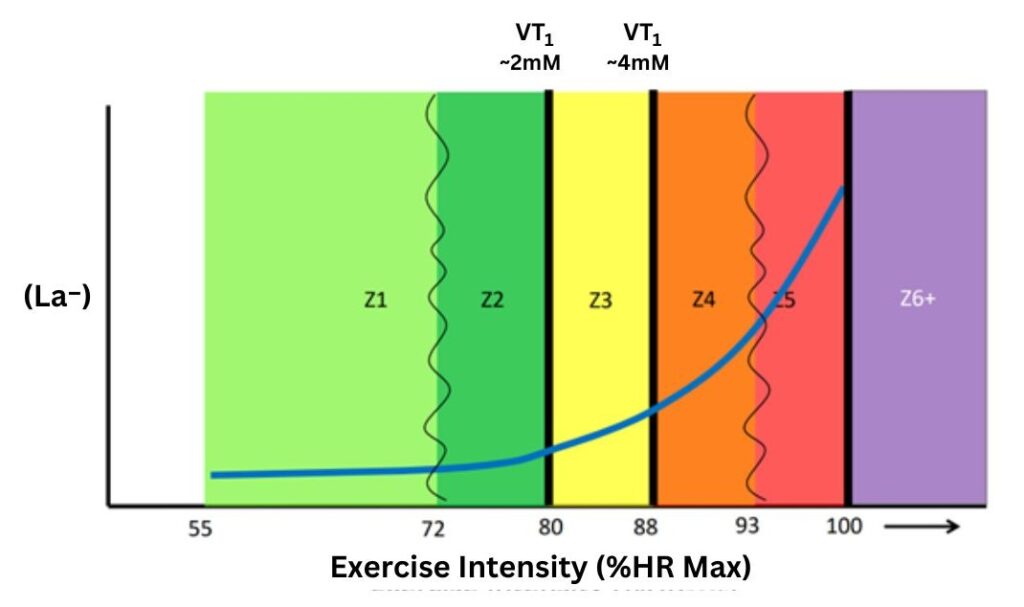
With the Sydney Marathon Festival fast approaching it’s interesting to look at the training intensity distribution of the best endurance athletes across different sports. Many people feel that to reach their maximum running performance they need to be pushing really hard in almost every session, but what we learn from these elite athletes is quite different.

What you can see is that the majority of the best endurance athletes in the world are spending the majority of their training time in the lowest intensity training zones. Yes, they are accumulating a LOT of time in these zones but it is interesting that they are performing very small amounts of high intensity training comparatively.
These athletes have recognised that the lower intensity training better prepares their body to perform the higher intensity work at a better level than when they attempt to do it too frequently.
How Do Low Intensity Training Sessions Improve Running Performance?
One of the biggest benefits of low intensity training is that it increases stroke volume (amount of bloody ejected by the heart per heart beat). Stroke volume maxes out at about 65% of max heart rate and continuing to exercise at a greater intensity offers no greater benefits. Because we are able to sustain lower intensity forms or exercise for longer periods we can spend a greater duration of time working on building a bigger stroke volume than with higher intensity exercise, and therefore achieve better results.
Another benefit of low intensity exercise performed over an extended period of time is the increase in the number and size of mitochondria. These are the oxygen carrying cells of the body. An increase in number and size of these means there is more oxygen available for the working muscles, leading to an improvement in running and exercise performance.
Another benefit is that there is less injury risk associated with lower intensity training sessions. By gradually exposing our muscles, tendons and bones to sustained low intensity loads over time we develop great resilience in these structure resulting in less injury, more consistent training and overall better results. Studies at the AIS demonstrated athletes who complete greater than 80% of their planned training are 7x more likely to achieve their performance goals than those who don’t!
How Low Should You Go?
The top endurance athletes are spending the majority of their training time in zone 1 which equates to approximately 55-70% max heart rate. You can see from the graph on the right that very little time is being spent in zones 4 and 5 which equate to 90-100% max heart rate.

Is High Intensity Training Important At All?
Yes, absolutely. High intensity training has many benefits that can transfer over to endurance performance.
– Increases in VO2 max ( the maximum amount of oxygen delivered to the working muscles) occur with high intensity training
– We develop performance specific adaptations to the event we are training for by training at speeds and intensities that related to it.
– We activate a greater % of our fast twitch muscle fibres with higher intensity training. As a result we are able to train our body to produce and maintain greater running speeds and become more efficient at faster speeds
– We also become more efficient at submaximal speeds as a smaller % of muscle fibres is now required to maintain sub maximal speeds
Summary Of Low Intensity Running Training
To achieve success in an endurance based event you need a balanced program that combines both low and high intensity training. However, the best endurance athletes in the world have shown us that the majority of that training should be spent at lower intensities, with only sprinklings of higher intensity training. Our bodies cannot repeatedly perform higher intensities of exercise and recover adequately from them to see consistent improvements in endurance performance. Excessive fatigue or injury are the more likely scenarios.
By spending a large majority of your training at lower intensities you are able to sustain the training load for longer periods, resulting in better longer term results and ultimately achieve a higher level of performance. Don’t be fooled though, the best endurance athletes in the world are also spending a lot of hours training at these lower intensities which allows them to achieve high level results with only small doses of higher intensity training. If you ultimately want to perform well in endurance events you need to put the time into the training to reach your potential. What will surprise many though is that the amount of ‘hard’ or ‘high intense’ training to achieve this is quite low!
Ben Liddy – Head Of running Performance

This article is provided by Ben Liddy, a certified World Athletics Level 4 Middle and Long Distance Running Coach. Ben works with runners of all abilities, from elite (Olympic/National/State) to recreational. He also manages our senior and junior Central Performance Track invitation squads.
Ben also delivers our RunRight running coaching program. These 1:1 treadmill sessions are designed to help you run faster with less chance of injury. They cater for all levels of running experience and ability.
As well as a World Athletics coach, Ben is a running physio with over 15 years experience. He has particular knowledge managing bone stress injuries, tendinopathies, and running-related knee and foot pain.
If you would like to ask Ben a question click below to email him or call us on 9280 2322. To book a session, click below.

